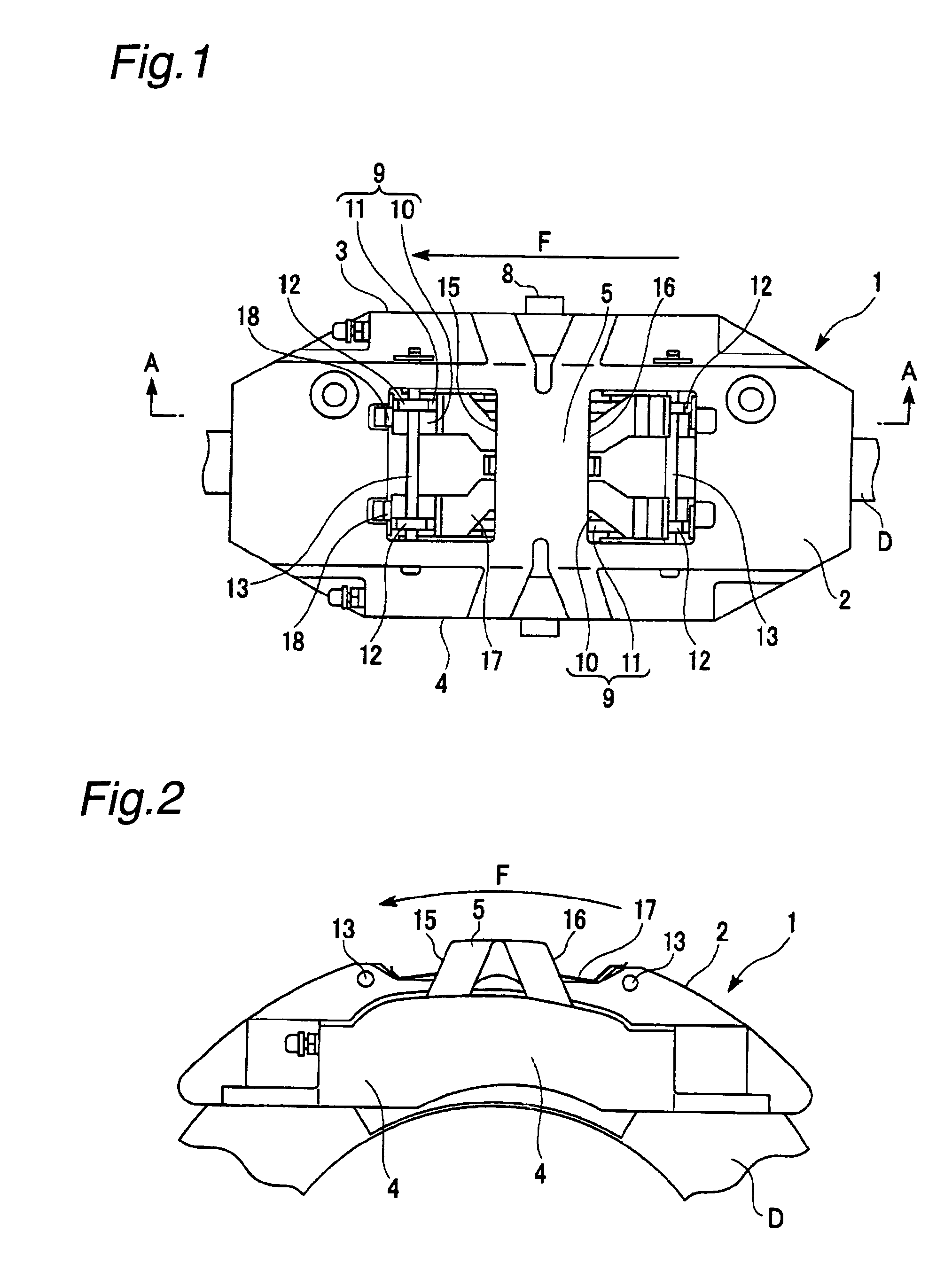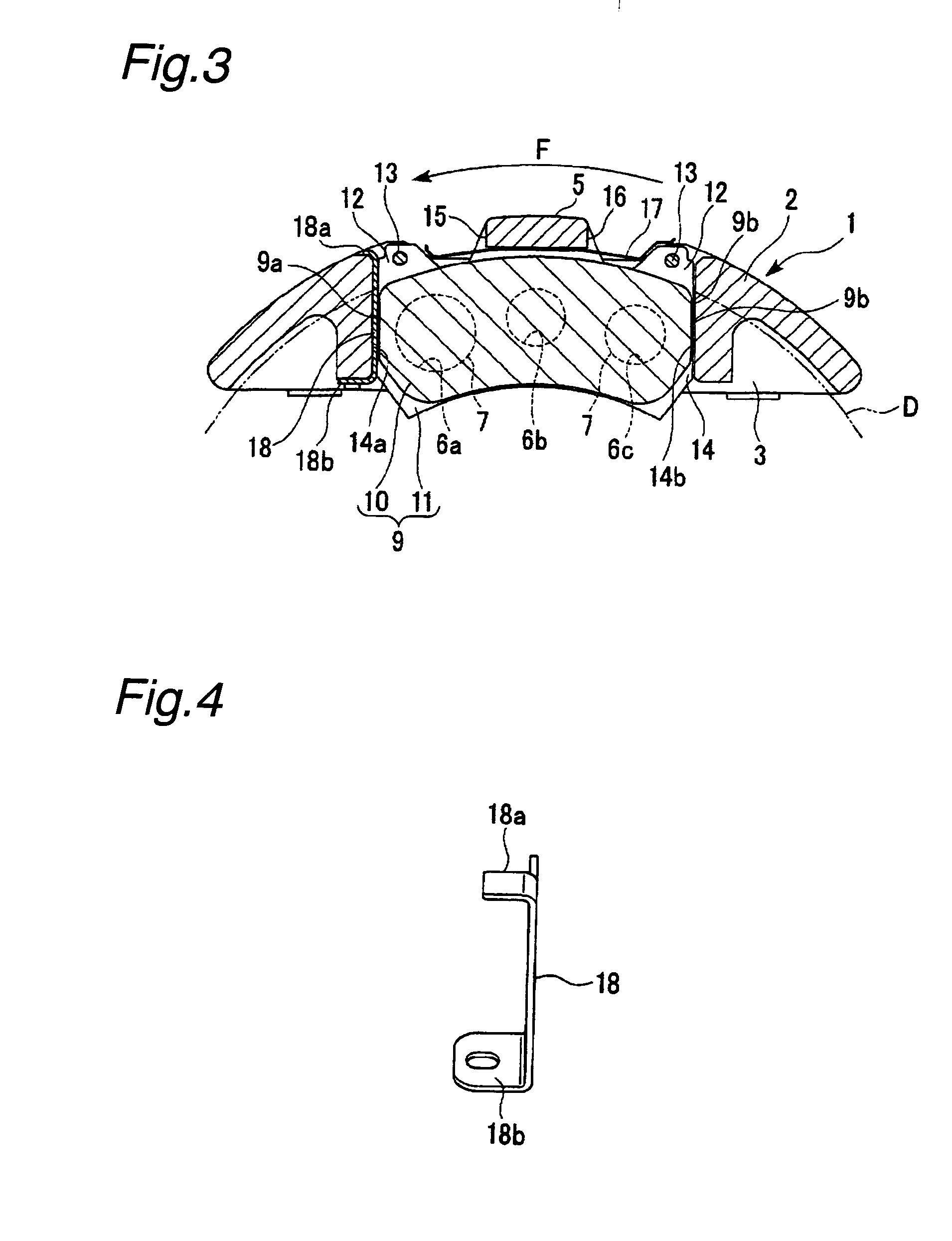Disc brake
a disc brake and disc technology, applied in the direction of noise/vibration control, slack adjusters, brake elements, etc., can solve the problems of affecting the braking performance of the disc brake, the guide member is more likely to rattle during the rearward braking operation of the vehicle, and the torque-receiving surface may become recessed
- Summary
- Abstract
- Description
- Claims
- Application Information
AI Technical Summary
Benefits of technology
Problems solved by technology
Method used
Image
Examples
first embodiment
[0032] First, the disc brake according to the present invention will be described with reference to FIGS. 1 to 4.
[0033] This disc brake comprises: a brake disc (disc) D adapted to rotate with an axle; and a brake caliper 1 fixed to the side of a vehicle body. A caliper body 2 of the brake caliper 1 is made of a single block of an aluminum alloy (for example, AC1B-T4, AC2A-T6, or AC4CH-T6). It is to be noted that an arrow F in the figures indicates a direction of rotation of the brake disc D when a vehicle moves forward, and that a hardness of the aluminum alloy used in the caliper body 2 of the present embodiment is about Hv 90.
[0034] As shown in FIG. 2, the caliper body 2 is formed to be substantially arc shaped from a lateral view point, and has a guide groove (not shown) in an inner circumferential side of the arc, the guide groove being formed to cover an outer circumferential edge of the disc D. This guide groove is defined by: an inner wall 3 facing a surface of the disc D on...
second embodiment
[0049] Next, the second embodiment will be described with reference to FIGS. 8 to 10.
[0050] In the disc brake of the present embodiment, a caliper body 202 of a brake caliper 1 is made of a single block of aluminum as is the case in the first embodiment. Inner and outer walls 3 and 4 of the caliper body 202 are each provided with two pistons 7 that are arranged side by side in a rotational direction of the disc, the two pistons 7 in the inner wall 3 and the two pistons 7 in the outer wall 4 being disposed in opposing relation to each other. Brake pads 9A and 9B are provided on front surfaces of the pistons 7 on either side of the disc D. The inner and outer walls 3 and 4 each have two guide grooves 14A and 14B for slidably holding the brake pads 9A and 9B. The guide grooves 14A and 14B are provided, on opposite sides thereof in a circumferential direction, with forward torque-receiving surfaces 14Aa and 14Ba and rearward torque-receiving surfaces 14Ab and 14Bb. Opposing sides of eac...
third embodiment
[0054] Next, the third embodiment will be described with reference to FIGS. 11 and 12.
[0055] The disc brake of the present embodiment has the same numbers of pistons 7, brake pads 309, and so on as that of the first embodiment. A metal backing member 311 for each brake pad 309 has locking hooks 30 extending integrally from the metal backing member 311 in forward and rearward rotational directions of the disc. Therefore, the present embodiment is significantly different from the other embodiments in that these locking hooks 30 are hooked and locked to respective stays 31 that project from a caliper body 302. In the first embodiment, a braking torque acting in a direction of rotation on a brake pad at a time of braking is counteracted by a torque receiving surface which pushes back the brake pad, and is provided on an outgoing side of rotation of the disc D (an exit side in the direction of rotation). In contrast, in the present embodiment, a braking torque acting in a direction of ro...
PUM
 Login to View More
Login to View More Abstract
Description
Claims
Application Information
 Login to View More
Login to View More - R&D
- Intellectual Property
- Life Sciences
- Materials
- Tech Scout
- Unparalleled Data Quality
- Higher Quality Content
- 60% Fewer Hallucinations
Browse by: Latest US Patents, China's latest patents, Technical Efficacy Thesaurus, Application Domain, Technology Topic, Popular Technical Reports.
© 2025 PatSnap. All rights reserved.Legal|Privacy policy|Modern Slavery Act Transparency Statement|Sitemap|About US| Contact US: help@patsnap.com



